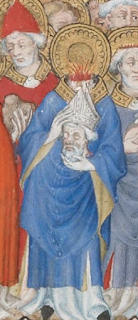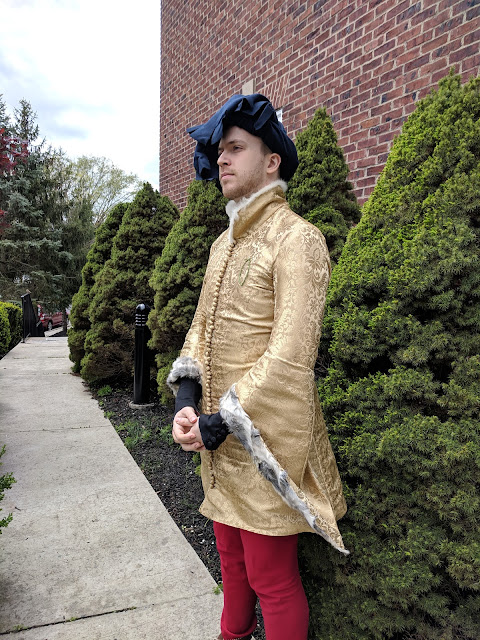My friend Vika (
who maintains a great blog) has gotten her writ for elevation to the order of the laurel, the SCA's highest award for arts and sciences. She requests that her attendants for her elevation dress in clothing that matches her persona, which is approximately 1377 and later Paris.
So I'm gonna need some clothing, since most of my stuff is three hundred years out of fashion. I'm aiming at clothing fitting a fashion-forward noble of some but not unlimited means. Based on my reading of
The Medieval Tailor's Assistant, here's what we're looking at:
Underclothes
- A shirt, which is basically the same construction as what I've been making, but with a circular neck hole, straight sleeves, and probably without the length to require slits.
- Breeches. These are basically short underwear in the period we're looking at.
- Hose. This will be an interesting challenge in fitting. I'm also curious about getting leather soles on them so that they can be used as shoes, since that was A Thing. It's not clear whether I should be going for joined or non-joined hose (although Vika informs me that joined hose are perhaps too late for this time period...), and the length will be determined by the doublet.
Doublet
We're well after "the fashion revolution of the mid-14th century" where people making linen armor padding combined their skills at fitting with fashion tailors. Doublets with set-in sleeves and careful body shaping are a pretty hard requirement for an outfit here. I'll have to learn a lot about this, but I've got some good books.
An argument could be made for a
Bocksten Man tunic, but if we're going to make fancy "late"-period clothes, let's go whole hog.
Outerwear
This is an interesting question. The Medieval Tailor's Assistant suggests that I should be looking at a cotehardie, which is a close-fitting buttoned garment with short sleeves. But starting in 1390, they say, we see the houpelande, which is a roomier gown with a more interesting shape. And fewer buttons. Understanding this transition will be an important topic.
Accessories
If I'm wearing a cotehardie, a conventional hood is probably appropriate. If not, one of the hoods-turned-hat solutions is more likely. Coifs and such are also reasonable, but I think the silliest hat possible is the right move.
I'm probably not going to get a new belt for this endeavor.
Research
Before diving into garment construction for anything other than the underwear, I want to look at some sources. The first one I want to look at is
The Petites Heures of Jean de France, Duc de Berry. This book of hours contains a large number of religious scenes, most drawn between 1375 and 1390 (with
one exception from 1410), which is perfect for our investigation.
Let's dig in. Keep in mind that while these are likely representations of people in clothing mostly current to the artist, they are affected by the context they are in. I'm not a very good scholar of Christian imagery so I'm definitely going to miss some stuff. I'm looking for primarily upper-class people, but it's worth noticing what other folks are wearing too: as we'll see, that will be instructive for some of the questions about the doublet layer, which isn't exposed on the nobles. For similar reasons, I'm ignoring clearly ecclesiastical clothes, angels, children, women, etc.
Also, I'm pretty new at this so I'm very likely going to make some mistakes - let me know so I can correct them!
Probably-Cotehardies
The buttons down the front of this garment, and its close-fitting nature imply cotehardie to me. The long sleeves are a counter argument, so this could be just a blue doublet.
I parse this as a pink mantle over a pink short-sleeved cotehardie with sleeve extensions, over a pink doublet. It might actually be a looser gown over a doublet with funny elbow points.
This is probably Mr. De Berry himself, and we'll see him in similar clothes over and over again in this same pose.
Same deal, but with clearer lines. I think this is more obviously a cotehardie sleeve.
Similar, again.
Same pose, same clothes, from the front. We can see that this mantle-gown-thing doesn't have a closure, and we get a new view of the sleeve on the layer beneath it, on his right.
Same deal, but in red.
Same thing, but with a different hood on the mantle.
Very much the same thing, in grey.
Standing!
I think this depiction makes a case that 97v is indeed a cotehardie - the shoulder decoration on the probably-a-mantle is very similar.
This is a little less clear since we only see the sleeve.
Too grumpy 2 wear pink
Probably-Houpelandes
This is the first in a series of somewhat confusing gowns. The sleeves here belong in the houpelande class, but the silhouette is very loose: he's not wearing a belt. Note that the collar is a little unclear: it doesn't look high to me, but I can't see neck like I would expect were it low.
Same thing, but with a better view of the collar.
Another borderline case, this time under a mantle. The sleeves are too long to read as a cotehardie to me.
Also, neat shoes.
Three people wearing bag-sleeved houpelandes. Note the fairly coarse button spacing - although that could just be how it's drawn! The turned back cuffs are also interesting, as are the pleated red and green skirts, and the grey skirt's belt (?).
Another houpelande sleeve without the body shape.
Same, but with bag sleeves.
This one seems pretty clear to me, although I'm both confused and intrigued by the red decoration. This
could be a particularly puffy pourpoint, though.
Ok
these guys are dope. Red king is clearly wearing a houpelande, although interestingly it's a very long one. He also has a silly hat.
Honorable 1410 mention, because this guy looks rad:
Doublets and Hose
Most of these examples are from people of lower status. This is not entirely surprising, as wealthier people would be wearing layers over their doublets. This could also be a youth vs age thing: flaunt it if you've got it.
Interesting shaping on the chest. This might be more pourpoint than just a regular doublet. I can kiiind of make out a center back and shoulder seam, which seems like it's not double armholed.
Note the mid-thigh doublet length, and split colored hose, white and black. He wears his sword in a suggestive location.
Two people in matching green doublets and hose. The left one has blue and grey hose, with his white breeches showing, suggesting separate hose. The right one is wearing blue and red hose, and does not reveal breeches. In both cases, the doublets only go to the top of the thigh. They both wear black shoes.
Two folks with very similar outfits to the previous. The one on the left wears a hood.
Another mid-thigh doublet, with grey hose and shoes, as well as an apron.
LOBSTER MAN! He's wearing his dagger just like the man in the first doublet image, and snazzy red hose with pointy toes. Doublet length looks upper thigh to me, and he's avoiding the codpiece issue with the belt pouch.
Hats
I sort of only want to wear the sillier hats, so I'm ignoring the more boring caps and such.
This is a fairly standard hood-as-hat, although it might not be wearable as a hood at this point.
This is a very similar hood-hat. Blue man is hanging his hat behind him. There's also a black bag hat on the right.
Conclusions
What can we draw from these portrayals, if we take them as typical for the time and place we're targeting? I can suggest a few:
- The Duke of Berry wore cotehardies most often, but sometimes wore garments that have houpelande sleeves
- Both working (cross nailers) and noble (three kings) people wore houpelandes, of length ranging from mid-thigh to the floor. Was this a status symbol? Was this a youth vs age thing?
- Working peoples' doublets range from top of thigh to mid thigh.
- I didn't call this out above but doublets (or perhaps undershirts?) which cover the hand up to the knuckles are oddly common. Might be worth doing just to be different.
- Hose of different color were common among working people depicted in this book, but were not mandatory. Single color hose seem more common for nobles.































Comments
Post a Comment